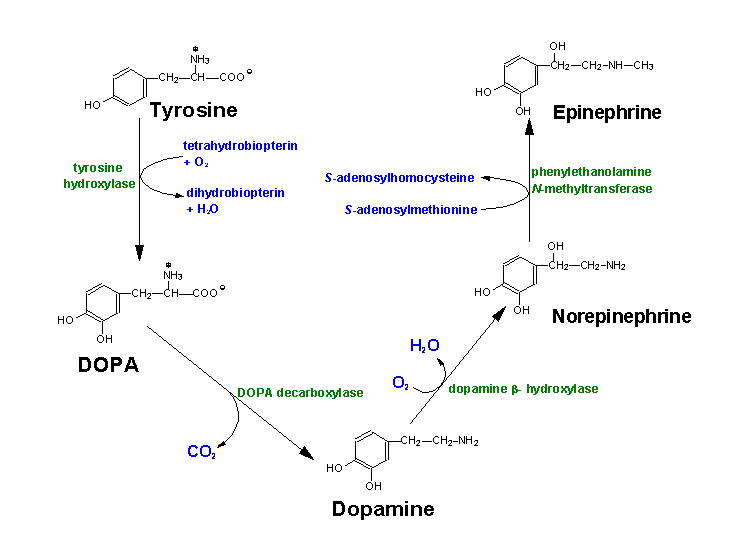This page has been
created as part of an undergraduate course at Davidson College.
Dopamine
WHAT IS DOPAMINE?
Dopamine (DA) is a monoamine neurotransmitter that upon binding to a dopamine receptor (G-protein coupled) releases a variety of downstream signals.
Dopamine structure

Dopamine is a derivative of the amino acid tyrosine (Y).† Tyrosine is modified by tyrosine hydroxylase to form DOPA.† DOPA decarboxylase then removes carbon dioxide from DOPA to for dopamine (C8H11NO2).† Dopamine then serves as a precursor to norepinephrine and epinephrine.† Dopamine, as well as norepinephrine and epinephrine, is packaged in granulated vesicles to be transmitted across the synapse (King, 2002).

Dopamine is mainly synthesized in areas of the central and
peripheral nervous systems, such as in the hypothalamus, the arcuate nucleus,
and the caudad (Velasco et al., 1998).†
Chromaffin cells produce dopamine within the dopaminergic regions (Unknown, 2003).
WHAT ARE THE FUNCTIONS OF DOPAMINE?
Dopamine plays a significant role in the cardiovascular, renal, hormonal, and central nervous systems.† It is thought to control processes as diverse as movement to drug addiction.† Dopamine dendrites extend into various regions of the brain, controlling different functions through the stimulation of α and β adrenergic and dopaminergic receptors (D1 and D2) (Velasco et al., 1998).
HOW IS DOPAMINE REGULATED?
There are several factors contributing to the regulation of dopamine.† The dopamine transporter (DAT), for example, regulates the uptake of dopamine into neurons.† Dopamine is thought to bind to DT via a separate binding domain that is constructed of multiple amino acid residues. These amino acid residues are not present in the primary structure of DT, but are thought to have interactions with the protein in its tertiary form (Chen et al., 2000).
MAO (monoamine oxidase) breaks down free dopamine (not contained in a vesicle).† MAO inhibition studies show an increase in dopamine concentrations in the absence of MAO.† This suggests that not only does MAO play a role in recycling the components of dopamine, but it also keeps the concentration of dopamine lower than the rate at which it is being produced (Shih et al., 1999).
DOPAMINE-RELATED DISEASES
Dopamine can either be present in deficient or excessive amounts; both causing disease.† Dopamine deficiency in the striatum or substantia nigra results in Parkinsonís-like symptoms.† In this case, movement becomes slow and rigid, accompanied by muscle tremor (Unknown, 2003).† Certain drugs, such as L-DOPA have been created to supplement the quantity of dopamine in the brain (Katzenschlager et al., 2002).† An excessive amount of dopamine is affiliated with schizophrenia, characterized by altered behavior, and delusions (Unknown, 2003).† Certain drugs, such as cocaine, block the return of dopamine into the brain, resulting in a build up of dopamine in the synapse, leading to drug-induced psychosis or schizophrenia (Unknown, 2003).
DOPAMINE'S UBIQUITOUS REPRESENTATION
Dopamine is present in both vertebrates and invertebrates.† The importance of dopamine is likely linked to the fact that the monoamine is conserved and present in all vertebrates.† Dopamine is also present in invertebrates, playing a significantly different role.† Dopamine, for example is a mild inducer of metamorphosis is some invertebrate species, possibly by gating and enabling the primary signaling pathway.† Molluscs release dopamine in the presence of stress.† The realease is part of a stress-pathway that promotes the maintenance of homeostasis (Unknown, 2003).
LINKS
History of dopamine-related research: http://www.narsad.org/pub/fall00nobel.html
Interaction of dopamine with amphetamine: http://www.fhs.mcmaster.ca/mcpharm/ejc/98ag_pa.htm
Dopamine and addiction:† http://www.utexas.edu/research/asrec/dopamine.html
Dopamine and Schizophrenia: http://serendip.brynmawr.edu/bb/neuro/neuro98/202s98-paper2/Frederickson2.html
Dopamine and Parkinsonís Disease: http://tcw2.ppsw.rug.nl/~vdbosch/pd.html
REFERENCES
Chen N, Reith ME.† (2000).† Structure and function of the dopamine transporter.† Eur J Pharmacol, 405(1-3):329-339.
Katzenschlager R, Lees AJ.† (2002).† Treatment of Parkinson's disease: levodopa as the first choice.† J Neurol, 249 Suppl 2:II19-II24.
Shih JC, Chen K, Ridd MJ.† (1999).† Monoamine oxidase: from genes to behavior.† Annu Rev Neurosci, 22:197-217.
Unknown.† (2003).† Dopamine.† University of Toronto.† 12 March 2003. http://www.zoo.utoronto.ca/zoo344s/2002Group7/_private/dopamine.htm.
Velasco M, Luchsinger A.† (1998).† Dopamine: Pharmacologic and Therapeutic Aspects.† Am J Ther, 5(1):37-43.
Please send any questions or comments
to: Monica Siegenthaler
Molecular Biology at Davidson
College
Back to my molecular biology home page
Spring 2003
